Text reproduced with permission from David MacMillan.
A number of sources, some of them quite authoritative, refer to either the Square Base Linotype or the Model 1 Linotype as the 'Simplex' Linotype. (At least one well-known source refers to both of these machines as the 'Simplex' Linotype!) However, there is no mention of a 'Simplex' model Linotype in any American source until 1954. Neither Ottmar Mergenthaler nor the (American) Mergenthaler company ever made a 'Simplex Linotype.'
The term is an alternative name for the version of the Model 1 Linotype manufactured by Mergenthaler Setzmaschinen GmbH in Germany. It is attested in the German literature by 1901, although it does not seem to have been used frequently until relatively recently. It entered American usage in an abridged 1954 translation of a German book on Mergenthaler. Since then, its use has spread and it has caused considerable confusion. There are now sources which claim that Ottmar Mergenthaler built this machine, that the Mergenthaler Linotype Company built it, that it was the Model 1, that it was the 'Square Base,' that it was the Model 1 and the Square Base, and even that it was the 'Blower' Linotype. None of these things are true. The name 'Simplex Linotype' has no place in the description of any American, British, Canadian, or any other non-German Linotype model.
Let's start by showing clearly what the 'Square Base' and Model 1 Linotypes in fact were.
The identity of the machine introduced in 1890 as the successor to the 'Blower' Linotype is secure. It is now commonly called the 'Square Base' Linotype (q.v.) to distinguish it from other machines, It had no special model name at the time it was produced. It was referred to simply as 'The Linotype' or, in very early literature from 1890 'The New Linotype' For example, in 1889 the Mergenthaler company said "We designate this improved machine as the New Linotype." It was called "New" so as to distinguish it from the Blower Linotype, which had only been brought to the attention of the trade in 1889 (MPC, 1890, p.7).
Here is an illustration of the visually distinctive machine introduced in 1890 as 'The Linotype' or 'The New Linotype' which has come to be called, informally, the 'Square Base Linotype':
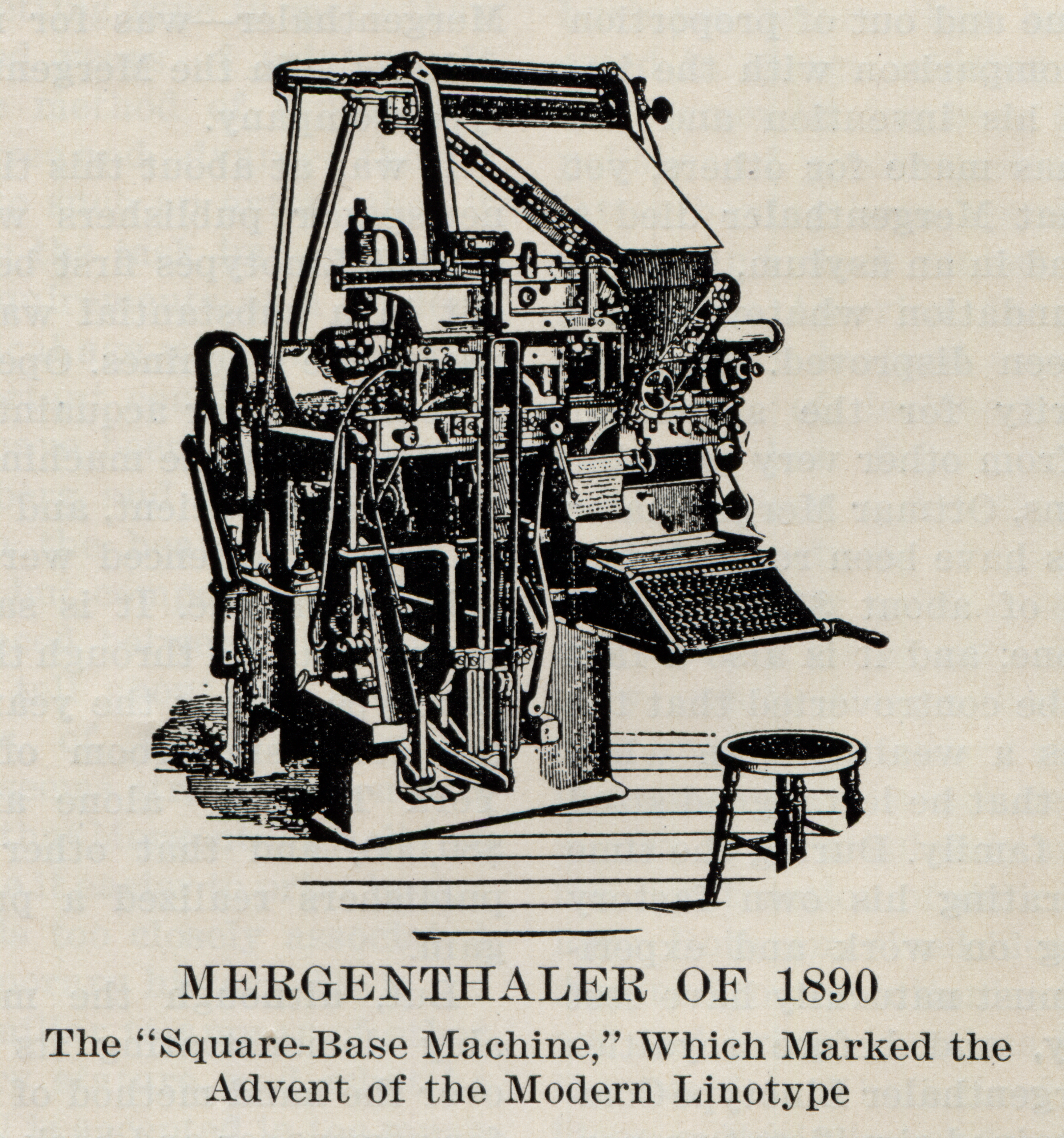
(Illustration from Pearson, 1935 p.48.)
Similarly, the identity of the machine introduced commercially in 1892 which was at introduction called simply 'The Linotype' but which has become known as the Model 1 is also secure. Unlike earlier machines, it remained a supported machine for many decades, and appears in Mergenthaler Linotype Company parts catalogs (There's nothing quite like a parts book to securely identify a machine). There is some confusion as to the date for this machine since a visually very similar machine was demonstrated in public in 1890 by Ottmar Mergenthaler (at the Judge Building in New York), but Mergenthaler Linotype Company records indicate that the first shipment was in 1892. Here it is as shown in the first ad for it in The Inland Printer, in 1893:
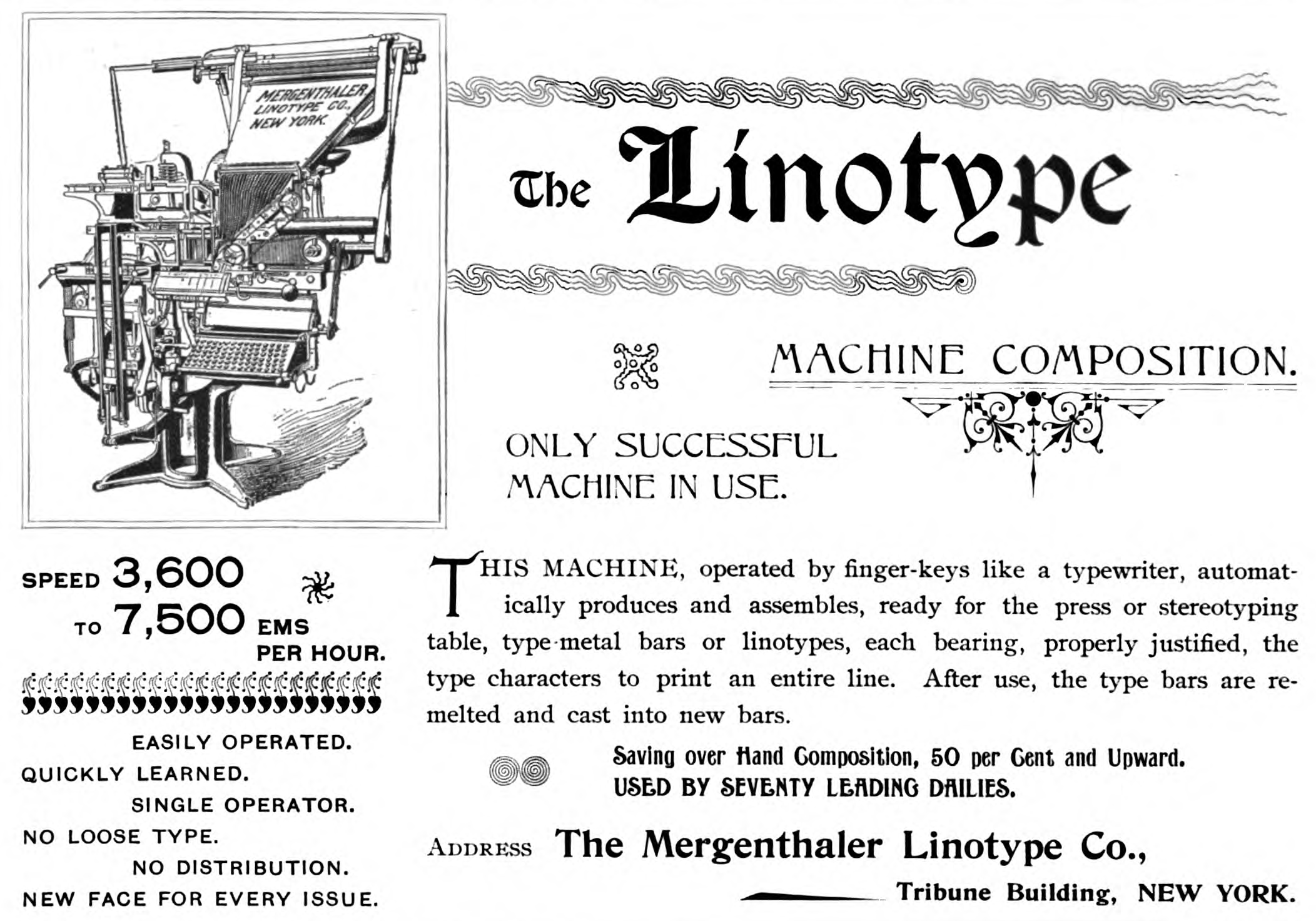
(From The Inland Printer. Vol. 10, No. 5 (Feb. 1893): 458. Digitized by Google from the Univ. of Michigan copy and available via The Hathi Trust.)
Here is the same cut used by the Mergenthaler Linotype Company in their overview of Linotype history in the 1914 edition of Suggestions to Linotype Machinists. In this 1914 source, they indicate that the Model 1 was obsolete, but still available on special order. (The 1916 edition of the same book says the same thing.)
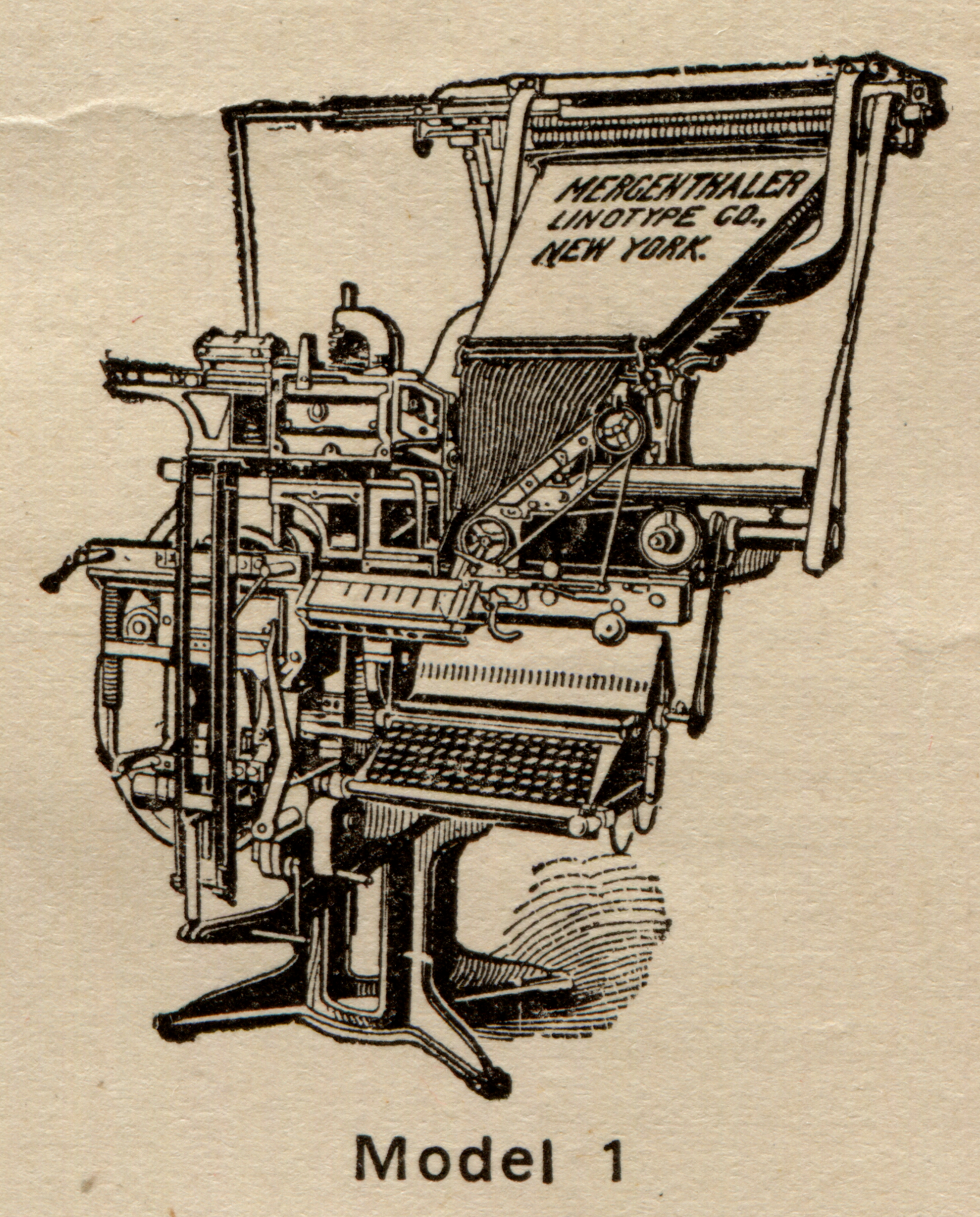
(Mergenthaler Linotype Company (MLC), 1914, p.5)
So when we use the name 'Square Base' we're using a clearly modern name to refer distinctively to a particular machine that had no special name at the time. When we use the name 'Model 1' we're using a name that was officially adopted by the Mergenthaler Linotype Company during the production of a particular machine. In either case we speak unambiguously.
Most of the references from the 1980s onward to a 'Simplex' Linotype are in popular accounts of the history of type. These are clearly all just copying each other and can be dismissed. But there are a few books of greater authority which lend credibility to the idea that there was a 'Simplex' machine. If you were writing a popular work today on the history of the Linotype, and you wished to research as far as authoritative secondary sources (but not actually do real research) you would cite Huss, Goble, Romano, or Kahan. Each says that there was a 'Simplex' Linotype, although they do not agree about which Linotype it was.
Huss (1973)
Richard Huss' 1973 The Development of Printers' Mechanical Typesetting Methods: 1822-1925 remains the only comprehensive study of the subject (Huss, 1973).
Huss correctly identifies and illustrates the Square Base Linotype. (He dates it to 1889, which is close; it was in development in that year, but did not ship until 1890). It is No. 116 in his catalog.
But Huss, in his catalog entry no. 124, uses the name 'Simplex' as the primary name for the Model 1. He also dates it to 1890, two years before its actual introduction, but Mergenthaler himself says that a version of this machine was exhibited in 1890. Huss calls this machine: 'Simplex Linotype (Model 1).' Huss cites no source for his identification of this machine as the 'Simplex,' and of course the illustration that he shows, from (Scientifc American, 1894), does not call it that. (The caption in the photograph used in Huss, reproduced below, is by Huss; it does not appear in the original 1894 article in Scientific American.)
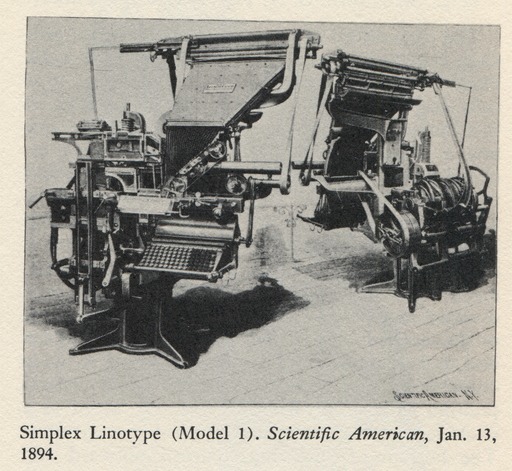
Goble (1984)
The definitive scholarly study of the history of the Linotype remains George Corban Goble's 1984 doctoral dissertation, The Obituary of a Machine (Goble 1984). Goble writes of the successor to the Square Base: "This was the Model 1, sometimes called the Simplex." Goble is usually meticulously well-documented, but in this case he cites no source for this information. The machine he illustrates in conjuntion with this is indeed the Model 1; he reprints the illustration from the 1894 article on it in Scientific American (Scientifc American 1894).
Romano (1986)
Frank Romano, in his generally very good 1986 book Machine Writing and Typesetting, confuses the 'Simplex,' the Square Base and the Model 1 completely. First he illustrates a Square Base machine but provides the caption "The Simplex Linotype (1890) provided the pattern for all later linecasters" (on the fifth unnumbered page of plates following p. 74).
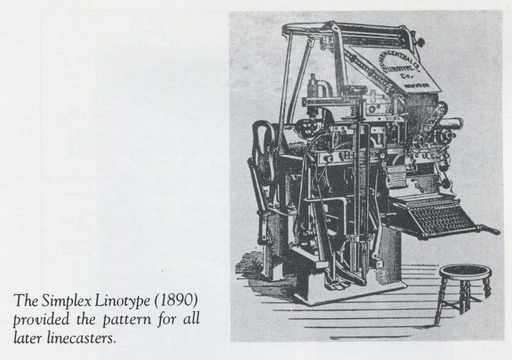
Yet on the tenth page of plates, he illustrates a Square Base machine again but supplies the caption: 'The 1890 Square Base Model 1 Linotype.'

Romano never actually illustrates a Model 1 Linotype. He provides no source for his use of the name 'Simplex.'
Kahan (2000)
Almost all books since Huss and Goble, while well intentioned, are simply copying Huss or Goble (or more commonly each other). One exception to this is Basil Kahan's extremely well researched biography Ottmar Mergenthaler (Kahan, 2000). This is the best biography of Mergenthaler yet written, and Kahan takes particular care to debunk several persistent Linotype myths.
Kahan uses the name 'Simplex' as the basic name for the Model 1. In his section 'The Simplex Linotype' in his chapter "The Linotype - A Technical Summary" he says:
"This ['The Simplex Linotype'] was the definitive model shown in the British Printer advertisement of figure 28. Although the Linotype was regularly enhanced during the hot metal era, all subsequent models conformed to the same basic design. The first model of this Linotype was built in February 1890 and displayed at the Judge Building in New York, but did not come into regular use before 1893 in the USA and 1895 in the United Kingdom."
"In time this machine became known as the Model 1, but the name can be misleading because the terms: Square Base, Simplex, and Model 1 are sometimes treated as synonymous. ..."
What Kahan says is correct in detail. The machine which became known as the Model 1 was shown, in prototype form, in Feb. 1890 in the Judge Building in NY. (We know this from Mergenthaler's (auto)biography (Mergenthaler, 1989, p.56-57.) Kahan's date of 1893 for commercial use is plausible. The Mergenthaler Linotype Company's 1971 salesman's book cited by Goble (1984, p.431), gives a date of 1892. The serial number list (of unknown provenance) gives a shipping date of August 1, 1892 for the first Model 1 (with serial number 579). But the first ad in The Inland Printer did not appear until February 1893. And Kahan is certainly correct that "the terms: Square Base, Simplex, and Model 1 are sometimes treated as synonymous"! The problem is that nowhere does Kahan present any evidence that this machine was ever called the 'Simplex.'
Here is Figure 28 from Kahan. It shows the English version of the Model 1 Linotype. The name 'Simplex' does not appear.
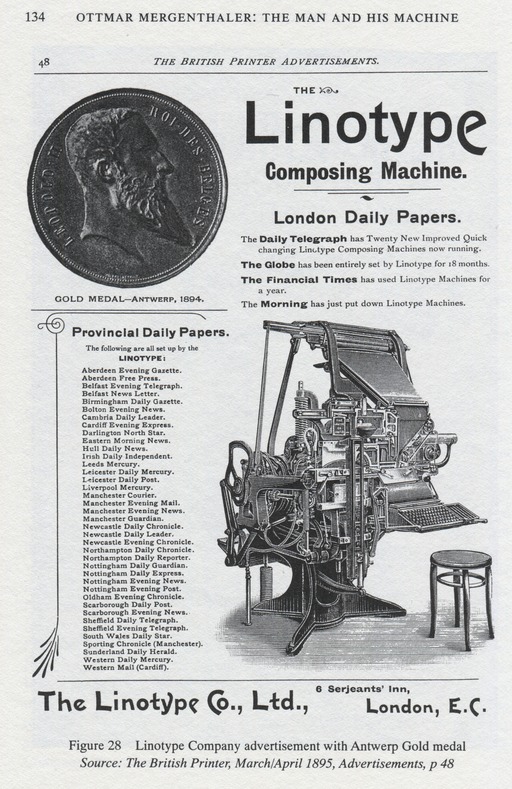
So when was the first use of the term 'Simplex Linotype' (to designate any machine)? One of the few advantages of the 21st century is that we now have the ability, thanks to Google Books and other digitization projects, to do reasonably comprehensive text search of historical literature. In such a search (done in 2013) I was unable to discover any use of the name 'Simplex Linotype' in any American source prior to 1954. Ottmar Mergenthaler never applied this name to any machine. It appears in no Mergenthaler company literature. It appears in no trade journal. It appears in no advertisement (not even in classified ads). It appears in no third-party book (not even in comprehensive histories of composing machinery).
The 'Simplex Linotype' did not exist in America, ever.
(As an aside, I can discover only one reference to a 'Simplex' Linotype in any English language source prior to 1954. In the classified advertisements of The British and Colonial Printer and Stationer in 1915 there appears an notice of the sale of a printing establishment. The contents mentioned include a 'MODEL ONE SIMPLEX LINOTYPE'. It is possible that this was a German machine. It is also possible that this ad was written by someone familiar with the German Linotypes who was mistakenly identifying an English Model 1 Linotype.)
The history of the name 'Simplex' begins in the German literature. What follows in the section here is pretty detailed - that's deliberate, as I'm simply trying to line up all of the data points. In summary:
The German licensee of the Linotype patents, 'Mergenthaler Setzmaschinen-Fabrik GmbH, Berlin' was founded in 1896. I do not yet know if its first product was a derivative of the Square Base Linotype or of the Model 1, but a derivative of the Model 1 was in production by at least 1901. Later German Linotype production and engineering differed considerably from American practice.
The earliest occurance I have so far been able to discover of a 'Simplex' Linotype occurs in a 1901 advertisement placed by this firm in the Archiv für Buchgewerbe (Archiv für Buchgewerbe, 1901). It isn't actually an instance in which the company uses this name for its own machine. Rather, it is an ad which illustrates the German derivative of the Model 1 and also reprints a letter from a customer which reports positively on their "Zweibuchstaben-Linotype-Setzmaschine ('Simplex')". ('Zweibuchstaben' = 'two-letter matrix').

The image that this advertisement uses to illustrate the machine is the stock cut of a Model 1 Linotype that I presume was distributed by the Mergenthaler Linotype Company. It appeared frequently. Here it is from a later source, my 1918 copy of John S. Thompson's Mechanism of the Linotype. It is identical, down to the pattern of the floorboards.
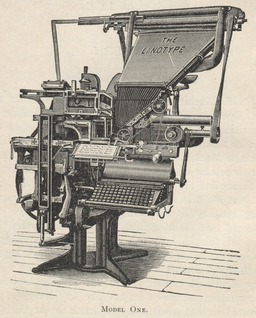
Figure from thompson (1918).
> PDF version of a JPEG conversion of this scan.
> Here is the original 1200dpi RGB PNG (26 Megabytes): thompson-mechanism-linotype-002-model-1-1200rgb-crop-3707x4598.png
So we know that by 1901 at least 'Simplex' was an a name being applied in Germany to the derivative of the Model 1 Linotype manufactured in that country.
I have been able to discover only nine other references to a 'Simplex' Linotype prior to 1954. All but one are in the German literature (the exception is in French). There are certainly more to be found; one difficulty is that much German literature in this period was printed in blackletter, and OCR software has a hard time with that. It is interesting that all but one (two if you include the 1901 item above) occur a decade or more after the German Model 1 must have ceased production.
All of these were found using Google Books, and for all of them only 'snippet' views are available. My citations, therefore, will be necessarily brief. Translations, given in [square brackets], are via Google Translate. I am well aware that many of the translations are, to be polite, not idiomatic. Between the OCR and the machine translation, this is a terribly mangled view of the past, but it's better than nothing.
I write this section with some misgivings. There has certainly been no lack of misinformation on this topic, and I am loathe to add to this with idle speculation.
Yet it is interesting to note that several of the German sources prior to Mengel speak of the 'Simplex' as the 'Style B' Linotype:
If there was a 'Style B' machine, there must have been a 'Style A' before it. With a complicated machine such as the Linotype, it never hurts to claim that your new model is simpler than your old model. This further suggests that far from being the 'Urmutter' of all Linotypes (as Mengel put it in 1954), the Simplex model was not even the first German Linotype.
On the other hand, only one of these references (Klimsch, 1909) is even close to the date of manufacture of this machine, so in the absence of any real evidence nothing should be made of this.
1954 was the centenary of Ottmar Mergenthaler's birth, and the German Linotype company (by then Linotype GmbH, Berlin and Frankfurt am Main) commemorated it by publishing Die Linotype Erreichte das Ziel by Willi Mengel. (This title translates to "The Linotype Reached the Target.") (91 pages, with a tipped-in color portrait of Ottmar Mergenthaler as a frontispiece and a tipped-in monochrome illustration of a modern four-magazine German Linotype just before the Contents at the end.) In the same year, an abridged translation of this book, with an additional introduction by Lin Yutang (a well-known Chinese scholar who took a special interest in mechanical typewriters). This was published by the Mergenthaler Linotype Company in Brooklyn as Ottmar Mergenthaler and the Printing Revolution. (63 pages, with the frontispiece of Mergenthaler but without the photograph of the German Linotype.)
Mengel's book was well-received. A favorable review of the American edition appeared in The Inland Printer in July of 1954.
In the book the 'Chronicle of the Linotype', Mengel refers twice to a 'Simplex' Linotype. Quoting here from the American edition (p.61):
In the main text, he presents a drawing of a German version of a Model 1, along with the claim that this is the Simplex Linotype of 1890, the "first mother of all Linotype models which later developed" ("Sie is die Urmutter aller Linotype-Modelle, die später entstanden.")

Here it is as it appeared in the American edition. The translation, while not exact, is idiomatic and not far from what Mengel said.

This is the first appearance in English of a claim that Ottmar Mergenthaler built a 'Simplex' Linotype. It appeared over half a century after his death.
As we have seen earlier, 'Simplex' was an alternative name applied to the German version of the Model 1 Linotype at some point between 1896 (when the German company was formed) and 1901 (the earliest attestation I can findd). The 'Simplex' Linotype is a derivative of the Model 1, not the Urmutter of all Linotypes.
The other error that Mengel makes has compounded the confusion. The Model 1 Linotype did not ship until 1892. In the 1890-1892 timeframe, the Square Base Linotype was shipping. By conflating the post-1896 German 'Simplex' Linotype with (a) the 1889 prototypes of the Model 1 and (b) the prototype exhibited in 1890 in the Judge Building by Mergenthaler, Mengel set a trap. Later authors, seeing '1890' and knowing that the 'Square Base' machine was shipping in 1890 have assumed that it was the 'Simplex.' (Though I admit that I cannot fathom how anyone came to think that the 1886 'Blower' Linotype was the 'Simplex.')
Mengel's book was popular, and the seed of error that he planted in it quickly grew.
The American edition of his book appeared by July of 1954 (when it was reviewed in The Inland Printer). By August of 1954 at the 96th Convention of the International Typographical Union (St. Paul, MN 14-20 Aug). A resolution (No. 138) which was 'A Tribute to Ottmar Mergenthaler' was passed. In part the text of this resolution claims "[whereas] On July 3, 1886, the Blower Linotype helped set the New York Tribune and after four years of development the Simplex Linotype was produced and regarded as a successful innovation in producing the printed word,…" (American Federation of Labor (AFL), 1954).
In an instant, a nonexistent machine - the Simplex Linotype of 1890 - was enshrined in the official documents of the American printing establishment.
To understand this article better, the question 'Why would someone bother with using this term?' requires an answer.
The term 'Simplex' has three different contexts:
As illustrated in chapter 5, The first usage of this term in relation with a machine was in an ad. The term could have been choosen to advertise how good the machine actually was. Would this be the case, the term could have been intended as:
In later mentions,it could also have referred to 'the simpler machines of the old days'.
But more probable is that the ad referred to the 'simplex' equipment, meaning one magazine, one set of mold liners and one ejector blade. In the time of the add, this was a common way to indicate the equipment bought with the machine. But after 1906, when the machines had evolved further, its original meaning probably became unclear. Later writers probably thought that the term related to a certain machine, which caused the misuse of the term and a lot of confusion.
We will probably never know for sure, except if better sources are found.
This literature review pointed out that the name 'Simplex' was first used by a customer in an ad from 1901. Chance is high that he just referred to his 'simplex' equipment that he had aquired together with his machine; meaning one magazine, one mold liner, and one ejector blade. But it is not clear if that was his intented meaning. After that, the term was used another couple of times, without clear reference to its meaning or to a specific machine. Only from 1934 on, the term became a clear reference to the 'original' American Model 1, 32 years after the commercial introduction of the American Model 1!
Errors were copied from other sources. In 1954, it was used in a German book German Linotype company written by Mengel Willy for the centenary of Mergenthaler's Birth. This book was translated to the English language, through which the error made its entrance in America and was taken over by several other publishers.
It is clear that the 'Simplex' Linotype was never made in America, and that the term should never be used to indicate any American Linotype model.
This was originally published at https://www.circuitousroot.com/artifice/letters/press/compline/technology/models/linotype-us/simplex/index.html#afb-38-7-282 and is republished here with permission from David MacMillan. Maarten Renckens made some adjustments and wrote chapter nine and ten, titled 'the meaning of the term simplex', and the 'conclusion'.
C 2021-2024 Maarten Renckens and other contributors. All rights reserved. All materials on this website are available for non-commercial re-use, as long as the original author is mentioned and a correct reference to this site is added. Thanks!
All materials are considered copyrighted by the author(s) unless otherwise stated. Some materials from other sources are used. If you find materials on this page which you consider not free from copyright, a notification is appreciated.
All collaborations and additional sources are more than welcome. Please contact info@maartenrenckens.com if you have materials that you deem valuable.